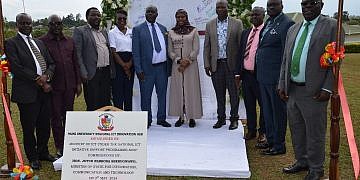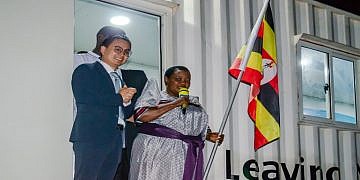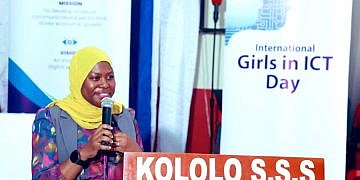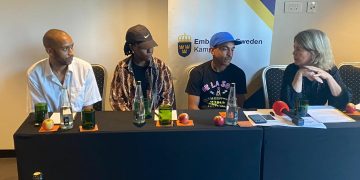President Museveni has fulfilled the shs1.2 billion pledge he last year made to 12 ghetto youth saccos in Greater Kampala Metropolitan Area.
Each sacco is to get shs100 million.
“From the Shs100 million you can do something for yourselves. In the villages, we’re encouraging people into commercial farming. It’s good that you have a base here in the town where you have small businesses, artisanship, services like salons and others. Those are areas you should participate in within your groups (constituencies),” the president told the youths.
He was on Wednesday meeting the leaders of these saccos at State House in Entebbe.
The group included 100 ghetto youth leaders who are also the heads of the 12 ghetto SACCOs in Kampala, Wakiso and Mukono.
The beneficiaries of the SACCOs are from Rubaga Kakeeka Zone dwellers, Kasangati Ghetto Community, Kampala Central Division, Nakawa Division, Makindye East, Kawempe South, Makindye west, Kawempe North, Mukono industrial, Kasokoso, Nansana division and Masajja Para Zone ghetto in Makindye.
During the meeting, the president underscored the role of the ghetto people in the liberation of Uganda.
“What you call ghetto people, in the 1950s used to be called “Abawejere” and they were centred around Katwe. When Uganda was fighting for independence, much of the activities were around Katwe and I think the first offices of the Uganda National Congress were located in Katwe and that is where I think Dr. I.K Musazi and Dr. Barnabas Kunuka and others operated from. Even Augustino Kamya who organised the boycott of Indian goods in 1958 was from Katwe,” he said.
“I linked up with the ghetto in 1968. I was there, Katwe is my place. I was not a ghetto boy myself; my background is in the villages with farmers. That is where I came from to go to university, but we (Student movement) wanted to link up with the “Bawejere”. The Head of the abawejere that time was Abbas Kibazo whom they used to call “Ssabawejere” so I linked up with them. So, this story of saying this is my first time to link up with the ghetto is not true.”
He explained that when former President Idi Amin announced his coup on the 25th of January, 1971, the former students together with the help of the Abawejere decided to fight him because
they believed in solving the problems of the people.
“We had and still have a program of the prosperity of the people and Idi Amin could not understand that. Of course, we had problems with Obote, but we were at least able to talk to him. That is why we had not taken the route for fighting. On January,27 1971, I left to fight Amin, so he ruled me for only 2 days. I left with two people from Kampala; Abbas Kibazo and Zubair Bakari and when we went to Mbarara, the people there added some other two chiefs. The five of us entered Tanzania where we met Mwalimu Nyerere and that’s how the fight against Idi Amin started. All the time when we were fighting Idi Amin, I used to come to Kampala and my contacts were mainly these bawejere,” he said.
“In 1971, we also recruited Ahmed Seguya who was from Katwe. He was among the 14 fighters I sent to Mozambique for training. When we went for the second battle in 1981 to fight Obote, Ahmed Seguya was our first army Commander but he died due to liver problems. Amin used to emphasise politics of identity based on religion saying he was fighting for Islam yet there was nothing he was doing for Muslims and other people also. During that time when I used to come to Kampala, I used to stay with my bawejere contacts who were mainly Muslims.”
The President further assured the ghetto youths that the National Resistance Movement (NRM) government is pro- people that emphasises politics of interest and works for all Ugandans.
On the other hand, President Museveni tasked the ghetto youths to advocate for the interests of the masses like free education for all and prosperity for all as well as embracing government poverty alleviation like the Paris Development Model (PDM) to uplift their livelihoods.
“Its good now that we have the group of Ddamulira which has linked up with you again, then we will be able to guide you on how to defend the interests of the masses. This is your country and home, you should defend it, you shouldn’t get involved in criminality like illegal protests,” he
said.
“In 1997, we launched UPE; education for all in government schools but the people you elect have paralyzed that effort on the ground by always putting charges and other excuses, but you don’t even talk about it. Now get moving, we are already sending all this money; the PDM, Emyooga and now we are adding on something else, and this is just the beginning.”
Museveni cautioned the ghetto youths against being used by politicians with selfish motives who always land them into criminality.
The Minister of Kampala Capital City and Metropolitan Affairs, Hajjat Minsa Kabanda thanked President Museveni for the support towards the ghetto people, a manifest that they are part and parcel of Uganda and contribute toward the development of Uganda.
“These people have been trained on how to manage their SACCOs and we are very sure that most of them are now transformed. Those who are yet to transform, will also be transformed,” Hajjat Kabanda said.
The Director of Crime Intelligence and project coordinator, Brig Gen. Christopher Ddamulira said the ghetto project started under the guidance of President Museveni in March 2022 and he has been working on it with his team under the leadership of the Minister for Kampala Capital City and Metropolitan Affairs, Hajjat Minsa Kabanda and the State House Comptroller, Jane Barekye.
“Previously, these ghetto youth did not have leadership but one thing which we did was to create leadership from the youth themselves, so we conducted elections through which we got leaders at zone, parish and division level.”
He added that the structure was launched by the Minister of Internal Affairs in August 2022 at Lugogo Indoor Stadium and upon the launch, they started on the process of organising the youths into SACCOs because they noticed that previously a number of people would lobby from the government for the ghetto youths, get resources, which never reach the intended recipients.
“What we did was to form the SACCOs and started training the leaders of those SACCOs on how to manage them and then we carried out the mobilisation to ensure that the members themselves begin to save under those saccos. Your excellency, after you launched them, we went into a super drive and as I speak now, we are talking about 3,280 savers in the 12 SACCOs and before you make available resources that you are going to provide today, the youths on their own had reached Shs13.7million from their own savings. We thank you for fulfilling the pledge that you made to them in Kololo last year,” Brig. Gen. Ddamulira said.






































